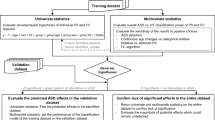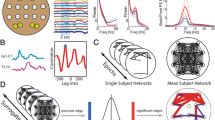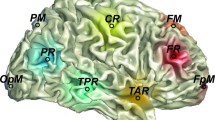Abstract
Neural oscillatory anomalies in autism spectrum disorders (ASD) suggest an excitatory/inhibitory imbalance; however, the nature and clinical relevance of these anomalies are unclear. Whole-cortex magnetoencephalography data were collected while 50 children (27 with ASD, 23 controls) underwent an eyes-closed resting-state exam. A Fast Fourier Transform was applied and oscillatory activity examined from 1 to 120 Hz at 15 regional sources. Associations between oscillatory anomalies and symptom severity were probed. Children with ASD exhibited regionally specific elevations in delta (1–4 Hz), theta (4–8 Hz), alpha (8–12 Hz), and high frequency (20–120 Hz) power, supporting an imbalance of neural excitation/inhibition as a neurobiological feature of ASD. Increased temporal and parietal alpha power was associated with greater symptom severity and thus is of particular interest.



Similar content being viewed by others
References
Aftanas, L. I., & Pavlov, S. V. (2005). Trait anxiety impact on posterior activation asymmetries at rest and during evoked negative emotions: EEG investigation. International Journal of Psychophysiology, 55, 85–94.
Blume, W. T. (2006). Drug Effects on EEG. Journal of Clinical Neurophysiology, 23, 306–311.
Bosboom, J. L. W., Stoffers, D., Stam, C. J., van Dijk, B. W., Verbunt, J., Berendse, H. W., et al. (2006). Resting state oscillatory brain dynamics in Parkinson’s disease: An MEG study. Clinical Neurophysiology, 117, 2521–2531.
Bourgeron, T. (2009). A symaptic trek to autism. Current Opinion in Neurobiology, 19, 231–234.
Canitano, R. (2007). Epilepsy in autism spectrum disorders. European Child and Adolescent Psychiatry, 16, 61–66.
Cantor, D. S., Thatcher, R. W., Hrybyk, M., & Kaye, H. (1986). Computerized EEG analyses of autistic children. Journal of Autism and Developmental Disorders, 16, 169–187.
Casanova, M. F., Buxhoeveden, D. P., & Brown, C. (2002a). Clinical and macroscopic correlates of minicolumnar pathology in autism. Journal of Child Neurology, 17, 692–695.
Casanova, M. F., Buxhoeveden, D. P., Switala, A. E., & Roy, E. (2002b). Minicolumnar pathology in autism. Neurology, 58, 428–432.
Cherkassky, V. L., Kana, R. K., Keller, T. A., & Just, M. A. (2006). Functional connectivity in a baseline resting-state network in autism. NeuroReport, 17, 1687–1690.
Chez, M. G., Chang, M., Krasne, V., Coughlan, C., Kominsky, M., & Schwartz, A. (2006). Frequency of epileptiform EEG abnormalities in a sequential screening of autistic patients with no known clinical epilepsy from 1996 to 2005. Epilepsy & Behavior, 8, 267–271.
Coben, R., Clarke, A. R., Hudspeth, W., & Barry, R. J. (2008). EEG power and coherence in autism spectrum disorder. Clinical Neurophysiology, 119, 1002–1009.
Collins, A. L., Ma, D., Whitehead, P. L., Martin, E. R., Wright, H. H., Abramson, R. K., et al. (2006). Investigation of autism and GABA receptor subunit genes in multiple ethnic groups. Neurogenetics, 7, 167–174.
Constantino, J. N., & Gruber, C. P. (2005). Social responsiveness scale (SRS). Los Angeles: Western Psychological Services.
de Jongh, A., Baayen, J. C., de Munck, J. C., Heethaar, R. M., Vandertop, W. P., & Stam, C. J. (2003). The influence of brain tumor treatment on pathological delta activity in MEG. NeuroImage, 20, 2291–2301.
DeLorey, T. M., Sahbaie, P., Hashemi, E., Homanics, G. E., & Clark, J. D. (2008). Gabrb3 gene deficient mice exhibit impaired social and exploratory behaviors, deficits in non-selective attention and hypoplasia of cerebellar vermal lobules: A potential model of autism spectrum disorder. Behavioural Brain Research, 187, 207–220.
Dumont, G. J. H., de Visser, S. J., Cohen, A. F., & van Gerven, J. M. A. (2005). Biomarkers for the effects of selective serotonin reuptake inhibitors (SSRIs) in healthy subjects. British Journal of Clinical Pharmacology, 59, 495–510.
Fisch, B. J. (1999). Fisch and Spehlmann’s EEG primer: Basic principles of digital and analog EEG (3rd ed.). New York: Elsevier.
Fries, P. (2005). A mechanism for cognitive dynamics: Neuronal communication through neuronal coherence. Trends in Cognitive Sciences, 9, 474–480.
Geisler, C., Brunel, N., & Wang, X. J. (2005). Contributions of intrinsic membrane dynamics to fast network oscillations with irregular neuronal discharges. Journal of Neurophysiology, 94, 4344–4361.
Hensch, T. K. (2005). Critical period plasticity in local cortical circuits. Nature Reviews Neuroscience, 6, 877–888.
Huang, M., Theilmann, R. J., Robb, A., Angeles, A., Nichols, S., Drake, A., et al. (2009). Integrated imaging approach with MEG and DTI to detect mild traumatic brain injury in military and civilian patients. Journal of Neurotrauma, 26, 1213–1226.
Hughes, J. R. (2008). Gamma, fast, and ultrafast waves of the brain: Their relationships with epilepsy and behavior. Epilepsy & Behavior, 13, 25–31.
Hughes, S. W., & Crunelli, V. (2005). Thalamic mechanisms of EEG alpha rhythms and their pathological implications. Neuroscientist, 11, 357–372.
Iacoboni, M., Lieberman, M. D., Knowlton, B. J., Molnar-Szakacs, I., Moritz, M., Throop, C. J., et al. (2004). Watching social interactions produces dorsomedial prefrontal and medial parietal BOLD fMRI signal increases compared to a resting baseline. NeuroImage, 21, 1167–1173.
Jokisch, D., & Jensen, O. (2007). Modulation of gamma and alpha activity during a working memory task engaging the dorsal or ventral stream. Journal of Neuroscience, 27, 3244–3251.
Kennedy, D. P., Redcay, E., & Courchesne, E. (2006). Failing to deactivate: Resting functional abnormalities in autism. Proceedings of the National Academy of Sciences of the United States of America, 103, 8275–8280.
Klimesch, W. (1999). EEG alpha and theta oscillations reflect cognitive and memory performance: A review and analysis. Brain Research Reviews, 29, 169–195.
Krug, D., & Arick, J. R. (2003). Krug Asperger’s Disorder Index. Los Angeles, CA: Western Psychological Services.
Laufs, H., Krakow, K., Sterzer, P., Eger, E., Beyerle, A., Salek-Haddadi, A., et al. (2003). Electroencephalographic signatures of attentional and cognitive default modes in spontaneous brain activity fluctuations at rest. Proceedings of the National Academy of Sciences of the United States of America, 100, 11053–11058.
Levitt, P. (2005). Disruption of interneuron development. Epilepsia, 46, 22–28.
Levitt, P., Eagleson, K. L., & Powell, E. M. (2004). Regulation of neocortical interneuron development and the implications for neurdevelopmental disorders. Trends in Neurosciences, 27, 400–406.
Lewine, J. D., Andrews, R., Chez, M., Patil, A. A., Devinsky, O., Smith, M., et al. (1999). Magnetoencephalographic patterns of epileptiform activity in children with regressive autism spectrum disorders. Pediatrics, 104, 405–418.
Loo, S. K., Teale, P. D., & Reite, M. L. (1999). EEG correlates of methylphenidate response among children with ADHD: A preliminary report. Biological Psychiatry, 45, 1657–1660.
Lord, C., Risi, S., Lambrecht, L., Cook, E. H., Jr., Leventhal, B. L., DiLavore, P. C., et al. (2000). The autism diagnostic observation schedule-generic: A standard measure of social and communication deficits associated with the spectrum of autism. Journal of Autism and Developmental Disorders, 30, 205–223.
Lorincz, M. L., Kekesi, K. A., Juhasz, G., Crunelli, V., & Hughes, S. W. (2009). Temporal framing of thalamic relay-mode firing by phasic inhibition during the alpha rhythm. Neuron, 63, 683–696.
Murias, M., Webb, S. J., Greenson, J., & Dawson, G. (2007). Resting state cortical connectivity reflected in EEG coherence in individuals with autism. Biological Psychiatry, 62, 270–273.
O’Connor, S. C., & Robinson, P. A. (2005). Analysis of the electroencephalographic activity associated with thalamic tumors. Theoretical Biology, 233, 271–286.
Oram Cardy, J. E., Flagg, E. J., Roberts, W., Brian, J., & Roberts, T. P. L. (2005). Magnetoencephalography identifies rapid temporal processing deficit in autism and language impairment. NeuroReport, 16, 329–332.
Orekhova, E. V., Stroganova, T. A., Nygren, G., Tsetlin, M. M., Posikera, I. N., Gillberg, C., et al. (2007). Excess of high frequency electroencephalogram oscillations in boys with autism. Biological Psychiatry, 62, 1022–1029.
Peelen, M. V., Atkinson, A. P., & Vuilleumier, P. (2010). Supramodal representations of perceived emotions in the human brain. Journal of Neuroscience, 30, 10127–10134.
Raichle, M. E., MacLeod, A. M., Snyder, A. Z., Powers, W. J., Gusnard, D. A., & Shulman, G. L. (2001). A default mode of brain function. Proceedings of the National Academy of Sciences of the United States of America, 98, 676–682.
Ramoz, N., Reichert, J. G., Smith, C. J., Silverman, J. M., Bespalova, I. N., Davis, K. L., et al. (2004). Linkage and association of the mitochondrial aspartate/glutamate carrier SLC25A12 gene with autism. American Journal of Psychiatry, 161, 662–669.
Roberts, T. P. L., Edgar, J. C., & Schwartz, E. S. (2009). Magnetoencephalography: Technique, clinical applications and future opportunities. In A. Holodny (Ed.), Functional neuroimaging: A clinical approach. New York: Informa Healthcare.
Roberts, T. P. L., Khan, S. Y., Rey, M., Monroe, J. F., Cannon, K., Blaskey, L., et al. (2010). MEG detection of delayed auditory evoked responses in autism spectrum disorders: Towards an imaging biomarker for autism. Autism Research, 3, 8–18.
Rockstroh, B., Wienbruch, C., Ray, W. J., & Elbert, T. R. (2007). Abnormal oscillatory brain dynamics in schizophrenia: A sign of deviant communication in neural network? BMC Psychiatry, 7, 44.
Rubenstein, J. L. R. (2010). Development of the cerebral cortex: implications for neurodevelopmental disorders. Journal of Child Psychology and Psychiatry, Early view, article first published online: 24 Aug 2010.
Rubenstein, J. L. R., & Merzenich, M. M. (2003). Model of autism: Increased ratio of excitation/inhibition in key neural systems. Genes, Brain, and Behavior, 2, 255–267.
Rutter, M., Bailey, A., & Lord, C. (2003). Social Communication Questionnaire (SCQ). Los Angeles: Western Psychological Services.
Salmelin, R., & Hari, R. (1994). Characterization of spontaneous MEG rhythms in healthy adults. Electroencephalography and Clinical Neurophysiology, 91, 237–248.
Scharfman, H. E. (2007). The neurobiology of epilepsy. Current Neurology and Neuroscience Reports, 7, 348–354.
Scherg, M., Ille, N., Bornfleth, H., & Berg, P. (2002). Advanced tools for digital EEG review: Virtual source montages, whole-head mapping, correlation, and phase analysis. Journal of Clinical Neurophysiology, 19, 91–112.
Sohal, V. S., Zhang, F., Yizhar, O., & Deisseroth, K. (2009). Parvalbumin neurons and gamma rhythms enhance cortical circuit performance. Nature, 459, 698–702.
Tallon-Baudry, C., Bertrand, O., Delpuech, C., & Permier, J. (1997). Oscillatory gamma-band (30–70 Hz) activity induced by a visual search task in humans. Journal of Neuroscience, 17, 722–734.
Uhlhaas, P. J., Pipa, G., Neuenschwander, S., Wibral, M., & Singer, W. (2011). A new look at gamma? High (>60 Hz) γ-band activity in cortical networks: Function, mechanisms, and impairment. Progress in Biophysics and Molecular Biology, 105, 14–28.
Uhlhaas, P. J., & Singer, W. (2006). Neural synchrony in brain disorders: Relevance for cognitive dysfunctions and pathophysiology. Neuron, 52, 155–168.
Venables, N. C., Bernat, E. M., & Sponheim, S. R. (2009). Genetic and disorder-specific aspects of resting state EEG abnormalities in schizophrenia. Schizophrenia Bulletin, 35, 826–839.
Wang, X. (2010). Neurophysiological and computational principles of cortical rhythms in cognition. Physiological Reviews, 90, 1195–1268.
Wechsler, D. (2003). Wechsler intelligence scale for children (3rd ed.). San Antonio, TX.: The Psychological Corporation.
Whittington, M. A., Traub, R. D., Kopell, N., Ermentrout, B., & Buhl, E. H. (2000). Inhibition-based rhythms: Experimental and mathematical observations on network dynamics. International Journal of Psychophysiology, 94, 315–336.
Willoughby, J. O., Fitzgibbon, S. P., Pope, K. J., Mackenzie, L., Medvedev, A. V., Clark, C. R., et al. (2003). Persistent abnormality detected in the non-ictal electroencephalogram in primary generalised epilepsy. Journal of Neurology, Neurosurgery and Psychiatry, 74, 51–55.
Acknowledgments
This study was supported in part by NIH grants R01DC008871 and R01DC008871-02S1 (TR) and T32NS007413 (LC). The content is solely the responsibility of the authors and does not necessarily represent the official views of the National Institutes of Neurological Disorders and Stroke or the National Institutes of Health. This research was also supported in part by grants from the Nancy Lurie Marks Family Foundation, the Jeffrey and Christina Lurie Family Foundation, Autism Speaks, and the Pennsylvania Department of Health. The Pennsylvania Department of Health specifically disclaims responsibility for any analyses, interpretations or conclusions. The authors thank the children and families who participated; Katelyn Cannon, John Dell, Sarah Khan, Peter Lam, Justin Monroe, and Jamie Rundio for their help with data collection; Saba Qasmieh for her help with participant recruitment; and Susan E. Levy and Gregory Miller for clinical insights and helpful discussions. Dr. Roberts gratefully acknowledges the Oberkircher Family for the Oberkircher Family Chair in Pediatric Radiology at Children’s Hospital of Philadelphia.
Author information
Authors and Affiliations
Corresponding author
Rights and permissions
About this article
Cite this article
Cornew, L., Roberts, T.P.L., Blaskey, L. et al. Resting-State Oscillatory Activity in Autism Spectrum Disorders. J Autism Dev Disord 42, 1884–1894 (2012). https://doi.org/10.1007/s10803-011-1431-6
Published:
Issue Date:
DOI: https://doi.org/10.1007/s10803-011-1431-6




